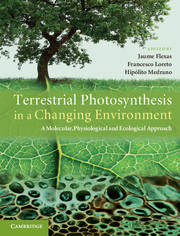 Terrestrial Photosynthesis in a Changing Environment
Terrestrial Photosynthesis in a Changing Environment Book contents
- Frontmatter
- Contents
- List of contributors
- Preface
- Acknowledgements
- List of abbreviations
- 1 Terrestrial photosynthesis in a changing environment
- Part I Photosynthesis
- Part II Measuring photosynthesis
- 9 Gas-exchange analysis: basics and problems
- 10 Optical methods for investigation of leaf photosynthesis
- 11 Stable isotopic compositions related to photosynthesis, photorespiration and respiration
- 12 Mesophyll conductance to CO2
- 13 Biochemical and molecular techniques for the study of photosynthetic processes
- 14 Measuring CO2 exchange at canopy scale: the eddy covariance technique
- 15 Remote sensing of photosynthesis
- Part III Photosynthetic response to single environmental factors
- Part IV Photosynthesis in time
- Part V Photosynthesis in space
- Part VI Photosynthesis in a global context
- References
- Index
10 - Optical methods for investigation of leaf photosynthesis
Published online by Cambridge University Press: 05 March 2013
- Frontmatter
- Contents
- List of contributors
- Preface
- Acknowledgements
- List of abbreviations
- 1 Terrestrial photosynthesis in a changing environment
- Part I Photosynthesis
- Part II Measuring photosynthesis
- 9 Gas-exchange analysis: basics and problems
- 10 Optical methods for investigation of leaf photosynthesis
- 11 Stable isotopic compositions related to photosynthesis, photorespiration and respiration
- 12 Mesophyll conductance to CO2
- 13 Biochemical and molecular techniques for the study of photosynthetic processes
- 14 Measuring CO2 exchange at canopy scale: the eddy covariance technique
- 15 Remote sensing of photosynthesis
- Part III Photosynthetic response to single environmental factors
- Part IV Photosynthesis in time
- Part V Photosynthesis in space
- Part VI Photosynthesis in a global context
- References
- Index
Summary
Optical methods
Light absorbed by chl. antenna is converted almost instantaneously into charge pairs in photochemical centres, which makes possible excitation by short flashes or modulated light thus generating various absorption, fluorescence or luminescence responses. The possibility of manipulating light excitation at will, together with the abundance of chromophores in the photosynthetic machinery, has favoured the development of optical monitoring of photosynthesis in vivo. The three complementary dimensions of optical methods, spectral, kinetic and imaging, provide unique tools to investigate the photosynthetic energy metabolism and, beyond, the bioenergetic status of the whole cell.
There is not a one-to-one correspondence between the measuring opportunities offered by various chromophores embedded in the thylakoid membranes and the aspects of the photosynthetic process they allow monitoring (Table 10.1). Starting from the mechanisms of light interactions with pigments, we will introduce the optical methods that have proved useful for studying leaf photosynthesis, using ‘intensive’ parameters (ratios such as Fv/Fm, kinetic amplitudes and time constants) that automatically compensate for variations of signal intensity between leaf samples. Other non-photosynthetic optical methods that can be used simultaneously (blue-green fluorescence (BGF), IR reflectance) will be briefly mentioned. Applications of leaf reflectance and fluorescence to remote sensing will be addressed in more detail in Chapter 15 and light absorption by leaves and canopies in Chapter 16.
- Type
- Chapter
- Information
- Terrestrial Photosynthesis in a Changing EnvironmentA Molecular, Physiological, and Ecological Approach, pp. 131 - 151Publisher: Cambridge University PressPrint publication year: 2012
- 3
- Cited by
